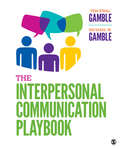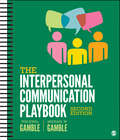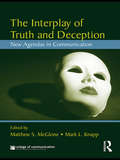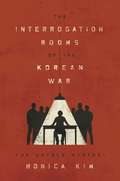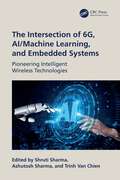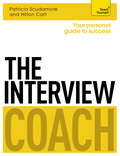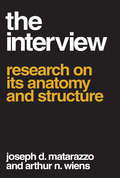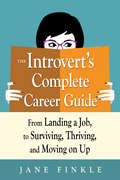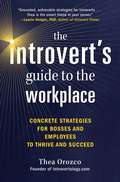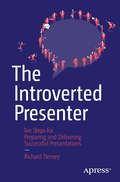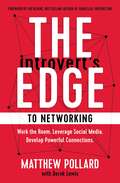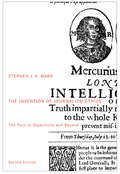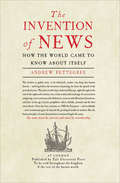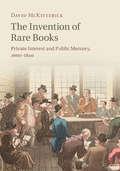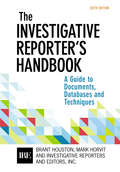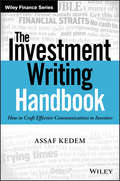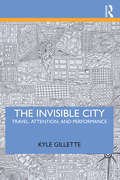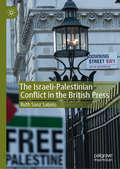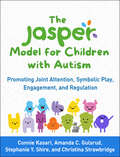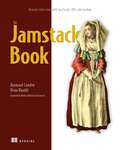- Table View
- List View
The Interpersonal Communication Playbook
by Teri Kwal Gamble Michael W. GamblePractical skills for developing successful relationships—both face-to-face and online Written in a conversational style and presented in an innovative handbook format, The Interpersonal Communication Playbook empowers you to take an active role in the development of your communication skills. Best-selling authors Teri Kwal Gamble and Michael Gamble provide you with abundant opportunities to make personal observations, analyze personal experiences, and assess personal growth across interpersonal contexts. Offering an array of communication settings for you to practice your skills, this text makes it easy for you to see how relevant theory can be applied to develop and maintain healthy relationships with family, friends, romantic partners, and coworkers. Key Features Insightful, relatable examples and real-world scenarios engage you and encourage you to critically reflect on your own communication dynamics. “Learning objectives at the beginning of each chapter outline key objectives and help you master important concepts and prepare for exams. Opening vignettes introduce the relevance of chapter content through a contemporary example of communication in action, exemplifying chapter themes with engaging and relevant stories. “What Do You Know?” features promotes self-assessment of knowledge and encourages you to address any misconceptions you discover. “Try This” boxes promote active learning and provide you with opportunities to put your skills into practice. “Reflect On This” boxes connect theory with practice—bringing key concepts and ideas to life. “Analyze This” boxes encourage you to apply critical thinking to examples of interpersonal encounters from literature and popular culture. “Connect the Case” features includes chapter-ending cases designed to help you assess interpersonal communication outcomes to help solidify and further develop the skills learned.
The Interpersonal Communication Playbook
by Teri Kwal Gamble Michael W. GambleWritten in a conversational style and presented in an innovative handbook format, The Interpersonal Communication Playbook empowers students to take an active role in the development of their communication skills in both physical and digital arenas. Bestselling authors Teri Kwal Gamble and Michael W. Gamble provide students with ample opportunities to make personal observations, examine personal experiences, and assess their personal growth across interpersonal contexts. The Second Edition features a new chapter on The Cultural Dynamics of Interpersonal Communication in response to the COVID-19 pandemic and lessons learned on adapting communication skills to changing conditions, ways to develop communication resiliency, and the value in practicing mindfulness. This title is accompanied by a complete teaching and learning package. Contact your SAGE representative to request a demo. Learning Platform / Courseware SAGE Vantage is an intuitive learning platform that integrates quality SAGE textbook content with assignable multimedia activities and auto-graded assessments to drive student engagement and ensure accountability. Unparalleled in its ease of use and built for dynamic teaching and learning, Vantage offers customizable LMS integration and best-in-class support. It’s a learning platform you, and your students, will actually love. Learn more. Assignable Video with Assessment Assignable video (available in SAGE Vantage) is tied to learning objectives and curated exclusively for this text to bring concepts to life. Watch a sample video now. LMS Cartridge: Import this title’s instructor resources into your school’s learning management system (LMS) and save time. Don’t use an LMS? You can still access all of the same online resources for this title via the password-protected Instructor Resource Site. Learn more.
The Interpersonal Communication Playbook
by Teri Kwal Gamble Michael W. GambleWritten in a conversational style and presented in an innovative handbook format, The Interpersonal Communication Playbook empowers students to take an active role in the development of their communication skills in both physical and digital arenas. Bestselling authors Teri Kwal Gamble and Michael W. Gamble provide students with ample opportunities to make personal observations, examine personal experiences, and assess their personal growth across interpersonal contexts. The Second Edition features a new chapter on The Cultural Dynamics of Interpersonal Communication in response to the COVID-19 pandemic and lessons learned on adapting communication skills to changing conditions, ways to develop communication resiliency, and the value in practicing mindfulness. This title is accompanied by a complete teaching and learning package. Contact your SAGE representative to request a demo. Learning Platform / Courseware SAGE Vantage is an intuitive learning platform that integrates quality SAGE textbook content with assignable multimedia activities and auto-graded assessments to drive student engagement and ensure accountability. Unparalleled in its ease of use and built for dynamic teaching and learning, Vantage offers customizable LMS integration and best-in-class support. It’s a learning platform you, and your students, will actually love. Learn more. Assignable Video with Assessment Assignable video (available in SAGE Vantage) is tied to learning objectives and curated exclusively for this text to bring concepts to life. Watch a sample video now. LMS Cartridge: Import this title’s instructor resources into your school’s learning management system (LMS) and save time. Don’t use an LMS? You can still access all of the same online resources for this title via the password-protected Instructor Resource Site. Learn more.
The Interplay of Truth and Deception: New Agendas in Theory and Research (New Agendas in Communication Series)
by Mark L. Knapp Matthew S. McGloneDuring the past 30 years, there have been a steadily increasing number of scientific and popular publications dealing with lying and deception. Questions about the extent to which public officials are deceptive are standard fare in current magazines and newspapers. This volume aims to present on a more precise conceptualization of this phenomenon, manifested in some well-known constructions like spin, hype, doublespeak, equivocation, and contextomy (quoting out of context). The contents of the volume have been generated for the New Agendas symposium at the University of Texas College of Communication, and all the authors are young, leading-edge researchers offering innovative perspectives and explorations of lying and deception in various contexts. This volume will appeal to scholars, researchers, and advanced/graduate students in communication, media, and psychology. It is written to the level of advanced undergraduates, and it is appropriate for use in courses covering lying and deception.
The Interrogation Rooms of the Korean War: The Untold History
by Monica KimA groundbreaking look at how the interrogation rooms of the Korean War set the stage for a new kind of battle—not over land but over human subjectsTraditional histories of the Korean War have long focused on violations of the thirty-eighth parallel, the line drawn by American and Soviet officials in 1945 dividing the Korean peninsula. But The Interrogation Rooms of the Korean War presents an entirely new narrative, shifting the perspective from the boundaries of the battlefield to inside the interrogation room. Upending conventional notions of what we think of as geographies of military conflict, Monica Kim demonstrates how the Korean War evolved from a fight over territory to one over human interiority and the individual human subject, forging the template for the US wars of intervention that would predominate during the latter half of the twentieth century and beyond.Kim looks at how, during the armistice negotiations, the United States and their allies proposed a new kind of interrogation room: one in which POWs could exercise their “free will” and choose which country they would go to after the ceasefire. The global controversy that erupted exposed how interrogation rooms had become a flashpoint for the struggles between the ambitions of empire and the demands for decolonization, as the aim of interrogation was to produce subjects who attested to a nation’s right to govern. The complex web of interrogators and prisoners—Japanese-American interrogators, Indian military personnel, Korean POWs and interrogators, and American POWs—that Kim uncovers contradicts the simple story in US popular memory of “brainwashing” during the Korean War.Bringing together a vast range of sources that track two generations of people moving between three continents, The Interrogation Rooms of the Korean War delves into an essential yet overlooked aspect of modern warfare in the twentieth century.
The Intersection of 6G, AI/Machine Learning, and Embedded Systems: Pioneering Intelligent Wireless Technologies
by Ashutosh Sharma Shruti Sharma Trinh Van ChienThis comprehensive guide to the emerging areas and synergistic relationships among the domains of 6G, machine learning, and embedded systems offers readers a detailed analysis of their converging paths and contributions to the development of intelligent wireless systems. Readers will gain a solid understanding of the principles and technologies behind 6G, machine learning, and embedded systems. They will learn how these three areas intertwine and why this intersection is pivotal for the next generation of wireless technologies.The contributors to this volume present a thorough and detailed analysis of this technology, highlighting its promising features, underlying technologies, and potential applications. The book first explores various applications of machine learning algorithms in areas such as network optimization, resource allocation, interference management, and intelligent data processing and analysis. Design considerations and challenges are presented, and case studies of innovative applications, such as smart cities, autonomous vehicles, healthcare, and industrial automation, are examined. The book concludes with a discussion of future trends and opportunities in this rapidly evolving field. Readers will benefit from the theoretical foundations and practical insights presented within and will be prepared to address future challenges and opportunities in these three fields.This book is a valuable resource for academic researchers and industry professionals working in the fields of wireless communication, machine learning, embedded systems, and artificial intelligence.
The Interview Coach: Teach Yourself
by Pat Scudamore Hilton CattBy the end of this book you will be fully prepared to give an outstanding interview .- Identify your strengths and weaknesses- Understand what interviewers are looking for- Practice your answers to typical questions- Build your confidence to tackle any situation- Get the job you wantOther books help you talk the talk. The Teach Yourself Coach books helps you walk the walk.Who are you? * Anyone with an interview coming upWhere this book take you?* You will be fully prepared to give an outstanding interviewHow does it work?* A combination of practical tried-and-tested advice, and unique interactive exercisesWhen can you do it?* In your own time, at your own paceWhat else do you get?* Access to free online videos and printable resourcesWhy Teach Yourself®?* Teach Yourself books are trusted around the world and have helped sixty million people achieve their goals
The Interview: Research on Its Anatomy and Structure
by Arthur N. WiensNearly two decades of research in clinic, industry, and educational settings have enabled the authors to present this compact but comprehensive report on the structure of the interview process. Joseph D. Matarazzo and Arthur N. Wiens have put together a concise presentation of research evidence; free from the dogged adherence to personal opinion that plagues most literature on the subject. The authors present and discuss basic interview concepts: interviewer and interviewee difference in interview behavior, the stability of such behavior, and conditions, which may modify it (including the first solid evidence, independently cross validated by others, for the effect on the interviewee of specific and common interviewer tactics).The book contains a wealth of data on differences in the interview speech behavior of different types of patients, and between persons in different occupations, different administrative hierarchies, and different professional specialties (for example surgical versus psychiatric nurses). Data from the clinical setting also includes evidence for a new and heretofore unsuspected process variable; i.e., a synchrony in the interruption behavior of the therapist and his patient over many psychotherapy sessions.The undergraduate in the communications fields will find this book an excellent adjunct to any of a number of courses in his special curriculum. Graduate students will find a storehouse of leads for theses and dissertations; while the practitioner and teacher in these fields will find much that is new and important to him in each chapter.
The Introvert's Complete Career Guide: From Landing a Job, to Surviving, Thriving, and Moving On Up
by Jane FinkleWhat do Elon Musk, Warren Buffet, Marissa Mayer, and Bill Gates all have in common outside of being wildly successful? They are all introverts. <P><P>In today's fast-paced, unstable workplace achieving success requires speaking up, promoting oneself and one's ideas, and taking initiative. Extroverts, fearless in tooting their own horns, naturally thrive in this environment, but introverts often stumble. If you question your ability to perform and succeed in this extroverted work culture, The Introvert's Complete Career Guide is custom fit for you.In this supportive, all-inclusive handbook, Jane Finkle demonstrates how to use your introverted qualities to their best advantage, then add a sprinkling of extroverted skills to round out a forceful combination for ultimate career success. Finkle shares the keys to navigating each stage of professional development--from self-assessment and job searching, to survival in a new position and career advancement. <P><P>In The Introvert's Complete Career Guide you will learn to:Build confidence by evaluating your values, personality style, interests, and achievements <P><P>Write the story of your career in resume and LinkedIn formats <P><P>Use social media at your own comfort level to promote your career and expand your network <P><P>Express yourself clearly and confidently in network meetings, interviews, and workplace situations <P><P>Build strong professional relationships with colleagues and senior leaders <P><P>Overcome fears that prevent you from embracing new challenges <P><P>Equally applicable to the real or virtual workplace, The Introvert's Complete Career Guide provides strategies, tools, and success stories that win you the professional respect and recognition you deserve.
The Introvert's Guide to the Workplace: Concrete Strategies for Bosses and Employees to Thrive and Succeed
by Thea OrozcoTap Into Your Natural Introvert Strengths in the Office with Actionable Tips and Advice Introverts make up one half of the population, and we&’re hardwired to thrive—especially in the workplace! However, it&’s not uncommon for introverts to feel out of place in the office, where it seems the only ones succeeding are outgoing personalities ready to toot their own horn. Thea Orozco busts that myth, showing how the workplace is truly a setting for introverts to succeed based on their innate skillset and natural introvert strengths. With topics ranging from overcoming phone phobia to developing an authentic leadership style, The Introvert's Guide to the Workplace guides introverts through thriving at work without having to shout—whether you are a boss, an employee, or a career person. Learn from actionable tips and practical advice, and surmount office challenges and let your introversion take the lead: Combat interview anxietyMake meaningful connections at networking eventsBe heard and noticed at meetings or on the stageOvercome imposter syndromeBecome an effective leader with your introvert strengthsAnd more! Including diverse expert interviews, The Introvert's Guide to the Workplace is every working introvert&’s handbook and guide that they can refer to throughout their career for guidance on tricky or draining situations and motivation to enlist the power of their inner introvert to succeed.
The Introverted Presenter
by Richard TierneyThe introvert is a personality type that draws energy from the outside inward. According to standard personality testing assessments, most people are introverts and no group is more introverted than technical professionals. Introverts are congenitally programmed to recoil from the prospect of public speaking with fear and loathing, yet making presentations to expert and non-expert audiences is an inescapable requirement for career advancement in any technical field. Presentation coach Richard Tierney rides to the rescue of fellow introverts in the IT and engineering sectors with The Introverted Presenter--his fail-safe guide to delivering competent presentations, no matter how unsuited by nature you might be to the performing arts. This short book lays out the complete process guaranteed to raise you from a debilitating state of terror and aversion to a comfortable place of clarity, calm, and competence--perhaps even brilliance, if you can train yourself to convert the free energy of your fear into controlled performance. Tierney repeatedly warns his introvert readers that they risk presentation fiasco if they skip, skimp, or change the order of any of the ten steps he prescribes for thoroughly and efficiently preparing their presentations. The surefire sequence of steps for The Introverted Presenter begins with defining your presentation''s audience and objective. The next step is to write the script of your speech in stages, constructing it on the basis of proven structural rules, cognitive laws, and dramatic tricks. Then you incrementally refine and tighten your script by delivering it iteratively, first in front of a mirror and then in front of increasingly critical test audiences, progressing from your cat to your boss. When you have a well-constructed and sound-tested script in hand and only then, you may create some slides to graft into your script in support of your opening action call and your concluding takeaways, which you commit to memory. Your slides should be limited to the smallest number possible (even zero) and the fewest possible words. What you''ll learn By following the process precisely as described in this book, even the most introverted technology professional will gradually but surely acquire the ability to Structure a killer presentation Coach yourself into being the best performer you can be Craft a presentation that supplies your audience''s technical needs while activating its human sympathies Use slides sparingly for best supporting effect Deploy elements of stagecraft like a trouper Who this book is for The primary readership is technology professionals who ordinarily shun the public-speaking limelight but find they need to pitch their work outside their team environments. The secondary readership is non-extroverts in the corporate, commercial, or academic worlds who have taken career promotions that involve presentations as part of their job descriptions. Table of Contents Chapter 1. Introverts and Presentations: Harnessing Terror Chapter 2. Face the Presentation Specter: Feared More Than Death Chapter 3. Find Your Presentation''s Focus: Ready, Steady Chapter 4. Impose Your Presentation''s Structure: Taking the Reins Chapter 5. Write Your Speech: Fear Returns Chapter 6. Refine Your Speech: Relishing the Panic Chapter 7. Try On Your Presenting Persona: Trotting the Course Chapter 8. Master Your Presentation Technology: Bending the Servant to Your Will Chapter 9. Chunk Your Presentation: Linking Primacy, Latency, and Failsafe Devices Chapter 10. Rehearse Your Presentation: Practice, Practice till Thoroughly Bored Chapter 11. Deliver Your Presentation: Treading the Hustings Like a Trouper Chapter 12. Encore! Rolling On to Your Next Presentation Chapter 13. Instant Clarity: Scaring Up an Emergency Presentation in One Day
The Introvert’s Edge to Networking: Work the Room. Leverage Social Media. Develop Powerful Connections
by Matthew PollardFinally – A Networking Book for Introverts!The sequel to Pollard&’s international bestseller The Introvert&’s Edge: How the Quiet and Shy Can Outsell Anyone, selected by BookAuthority as the #2 &“Best Introvert Book of All Time&” and listed by HubSpot as one of the &“Most Highly-Rated Sales Books of All Time.&”Introverts across the world have been sold a lie: One of the biggest myths that plagues the business world today is that our ability to network depends on having the &“gift-of-gab.&” This is nonsense. You don&’t have to be outgoing to be successful at networking. You don&’t have to become a relentless self-promoter. In fact, you don&’t have to act like an extrovert at all.The truth is, introverts make the best networkers . . . when armed with a plan that lets them be their authentic selves.Matthew Pollard, an introvert himself, draws on over a decade of research and real-world examples to provide an actionable blueprint for introverted networking.In this paradigm-shifting book, you&’ll discover how to:Overcome your fear and discomfort when networkingTurn networking into a repeatable systemLeverage your innate introverted strengthsTarget and connect with top influencersLeverage the power of virtual and social networkingWhether you&’re a small business owner struggling to make a living or a professional who&’s hit a career plateau, The Introvert&’s Edge to Networking is your path to a higher income and a rolodex of powerful connections.
The Invention of Journalism Ethics, Second Edition
by Stephen J.A. WardDoes objectivity exist in the news media? In The Invention of Journalism Ethics, Stephen Ward argues that given the current emphasis on interpretation, analysis, and perspective, journalists and the public need a new theory of objectivity. He explores the varied ethical assertions of journalists over the past few centuries, focusing on the changing relationship between journalist and audience. This historical analysis leads to an innovative theory of pragmatic objectivity that enables journalists and the public to recognize and avoid biased and unbalanced reporting. Ward convincingly demonstrates that journalistic objectivity is not a set of absolute standards but the same fallible but reasonable objectivity used for making decisions in other professions and public institutions. Considered a classic in the field since its first publication in 2004, this second edition includes new chapters that bring the book up to speed with journalism ethics in the twenty-first century by focusing on the growing dominance of online journalism and calling for a radical approach to journalism ethics reform. Ward also addresses important developments that have occurred in the last decade, including the emergence of digital journalism ethics and global journalism ethics.
The Invention of Journalism Ethics, Second Edition: The Path to Objectivity and Beyond (McGill-Queen's Studies in the History of Ideas #107)
by Stephen J.A. WardDoes objectivity exist in the news media? In The Invention of Journalism Ethics, Stephen Ward argues that given the current emphasis on interpretation, analysis, and perspective, journalists and the public need a new theory of objectivity. He explores the varied ethical assertions of journalists over the past few centuries, focusing on the changing relationship between journalist and audience. This historical analysis leads to an innovative theory of pragmatic objectivity that enables journalists and the public to recognize and avoid biased and unbalanced reporting. Ward convincingly demonstrates that journalistic objectivity is not a set of absolute standards but the same fallible but reasonable objectivity used for making decisions in other professions and public institutions. Considered a classic in the field since its first publication in 2004, this second edition includes new chapters that bring the book up to speed with journalism ethics in the twenty-first century by focusing on the growing dominance of online journalism and calling for a radical approach to journalism ethics reform. Ward also addresses important developments that have occurred in the last decade, including the emergence of digital journalism ethics and global journalism ethics.
The Invention of News: How the World Came to Know About Itself
by Andrew Pettegree&“A fascinating account of the gathering and dissemination of news from the end of the Middle Ages to the French Revolution&” and the rise of the newspaper (Glenn Altschuler, The Huffington Post). Long before the invention of printing, let alone the daily newspaper, people wanted to stay informed. In the pre-industrial era, news was mostly shared through gossip, sermons, and proclamations. The age of print brought pamphlets, ballads, and the first news-sheets. In this groundbreaking history, renowned historian Andrew Pettegree tracks the evolution of news in ten countries over the course of four centuries, examining the impact of news media on contemporary events and the lives of an ever-more-informed public. The Invention of News sheds light on who controlled the news and who reported it; the use of news as a tool of political protest and religious reform; issues of privacy and titillation; the persistent need for news to be current and for journalists to be trustworthy; and people&’s changing sense of themselves and their communities as they experienced newly opened windows on the world. &“This expansive view of news and how it reached people will be fascinating to readers interested in communication and cultural history.&” —Library Journal (starred review)
The Invention of Rare Books: Private Interest and Public Memory, 1600–1840
by David McKitterickWhen does a book that is merely old become a rarity and an object of desire? David McKitterick examines, for the first time, the development of the idea of rare books, and why they matter. Studying examples from across Europe, he explores how this idea took shape in the sixteenth and seventeenth centuries, and how collectors, the book trade and libraries gradually came together to identify canons that often remain the same today. In a world that many people found to be over-supplied with books, the invention of rare books was a process of selection. As books are one of the principal means of memory, this process also created particular kinds of remembering. Taking a European perspective, McKitterick looks at these interests as they developed from being matters of largely private concern and curiosity, to the larger public and national responsibilities of the first half of the nineteenth century.
The Investigative Reporter’s Handbook: A Guide To Documents, Databases, And Techniques
by Brant Houston Mark Horvit Investigative Reporters Inc. EditorsBuild the fundamental investigative writing and reporting skills you need to investigate anything and anyone. The text’s easy-to-use handbook style allows readers to quickly access any information--everything from how to build quality reporting skills and collaborate on investigations to tips for researching a variety of beats. This is the text on investigative reporting, infused with illustrative quotes and instructive examples from highly-respected journalists around the world.
The Investment Writing Handbook: How to Craft Effective Communications to Investors (Wiley Finance)
by Assaf KedemThe writing "bible" for financial professionals The Investment Writing Handbook provides practical, accessible guidance for crafting more effective investor communications. Written by an award-winning writer, editor, and speechwriter, this book explains the principles and conventions that help writing achieve its purpose; whether you need to inform, educate, persuade, or motivate, you'll become better-equipped to develop a broad range of communications and literature for investor consumption. Examples from real-world financial institutions illustrate expert execution, while explanations and advice targeted specifically toward investor relations give you the help you need quickly. From white papers and investment commentary to RFPs, product literature, and beyond, this book is the financial writer's "bible" that you should keep within arm's reach. Investment writing is one of the primary influences on investors' attitudes. It educates, informs decisions, shapes opinions, and drives behavior—so shouldn't it be expertly-crafted to achieve its intended goal? This book explains the "tricks of the trade" to help you get your message across. Understand the principles of effective investor communication Master the conventions of informative and persuasive writing Examine well-written sample documents from real-world institutions Improve research papers, presentations, investor letters, marketing literature, and more Virtually all firms with investors as clients need to communicate to them regularly, but few financial professionals receive formal training in investor communications. When investors' opinions, attitudes, and actions determine the health of your company, it is vitally important that these communications not be left to chance. The Investment Writing Handbook provides essential guidance and clear explanations to help you transform your communication strategy, execution, and results.
The Invisible City: Travel, Attention, and Performance
by Kyle GilletteThe Invisible City explores urban spaces from the perspective of a traveller, writer, and creator of theatre to illuminate how cities offer travellers and residents theatrical visions while also remaining mostly invisible, beyond the limits of attention. The book explores the city as both stage and content in three parts. Firstly, it follows in pattern Italo Calvino's novel Invisible Cities, wherein Marco Polo describes cities to the Mongol emperor Kublai Khan, to produce a constellation of vignettes recalling individual cities through travel writing and engagement with artworks. Secondly, Gillette traces the Teatro Potlach group and its ongoing immersive, site-specific performance project Invisible Cities, which has staged performances in dozens of cities across Europe and the Americas. The final part of the book offers useful exercises for artists and travellers interested in researching their own invisible cities. Written for practitioners, travellers, students, and thinkers interested in the city as site and source of performance, The Invisible City mixes travelogue with criticism and cleverly combines philosophical meditations with theatrical pedagogy.
The Invisible Game: The Secrets and the Science of Winning Minds and Winning Deals
by Kai-Markus Mueller Gabriele RehbockCutting-edge science can make all the difference for salespeople in a time when they are facing a business world in transformation. In The Invisible Game: The Secrets and the Science of Winning Minds and Winning Deals, neuroscientist Kai-Markus Mueller and sales professional Gabriele Rehbock deliver a hands-on guide to the hidden dynamics that influence the outcomes of most business deals. In plain English, the book unpacks recently discovered insights from psychology, behavioural economics, and neuroscience and explains how to apply them to your advantage in real-life business situations. The authors show you how to influence buying decisions and how to successfully respond to challenging business situations in order to put you in control of the levers that drive sales success. You&’ll also find Advanced strategies and tactics that offer a lasting edge in negotiations, sales and other business transactions Smart techniques to build rewarding customer relationships The psychology behind gains and losses revealing new keys to profitable pricing Real-life advice on how to counter a buyer&’s intimidation tactics: time, uncertainty, fear, and silence An essential, step-by-step playbook for sales professionals, The Invisible Game will also earn a place on the bookshelves of entrepreneurs, business owners, and other independent professionals—like lawyers, accountants, freelancers, consultants, and programmers—who regularly sell their services to other businesses.
The Irresistible Introvert: Harness the Power of Quiet Charisma in a Loud World
by Michaela ChungLearn the tools to shed your mask of extroversion, develop your own magnetism, and reveal the true you.One third to one half of Americans are introverts in a culture that celebrates-even enforces-an ideal of extroversion and a cult of personality. Political leaders are charismatic, celebrities bask in the spotlight, and authority figures are assertive. It is no surprise that a "quiet revolution” has begun to emerge among the "invisible” half of the population, asserting that they are just as powerful in their own unique ways.The Irresistible Introvert embodies the spirit of this revival and breaks down the myth that charisma is reserved for extroverts only. This mini manifesto shows introverts how to master the art of quiet magnetism in a noisy world-no gregariousness required! Within these pages, you’ll discover how to shed the mask of extroversion and reveal a more compelling (and authentic) you. You’ll also learn how to: Master the inner game of intrigue Manage your energy for optimal engagement Create an emotional ecosystem for charisma Establish introverted intimacy Cultivate communication skills for quiet typesAs a "professional” charismatic introvert, author Michaela Chung demonstrates that you no longer have to forcefully push yourself outward into the world against your nature, but can rather magnetize people inward toward the true you. In the process, you’ll learn to embrace your "innie life” and discover potential you never knew you had.
The Israeli-Palestinian Conflict in the British Press
by Ruth Sanz SabidoThe Israeli-Palestinian Conflict in the British Press provides an extensive empirical analysis of how the Israeli-Palestinian conflict has been constructed in British national newspapers since 1948. It traces the evolution of representations of the conflict by placing them in a historical context, with particular reference to Britain’s postcolonial relation to Palestine, and by presenting an in-depth analysis of the evolution of press language, including the use of terms such as ‘terrorism’ and ‘terrorist’ to classify agents of political violence. It applies an original approach to the study of media coverage, using a Postcolonial Critical Discourse Analysis framework, an innovative method that examines selected case studies in relation to theories of postcolonialism and discourse. Using this unique hybrid methodology, Sanz Sabido provides a thorough and precise unpicking of a highly mediated conflict.
The JASPER Model for Children with Autism: Promoting Joint Attention, Symbolic Play, Engagement, and Regulation
by Connie Kasari Amanda C. Gulsrud Stephanie Y. Shire Christina StrawbridgeThis full-color, clinician-friendly manual is the authoritative guide to implementing the Joint Attention, Symbolic Play, Engagement, and Regulation (JASPER) intervention. With a strong evidence base, JASPER provides a clear, flexible structure to bolster early skills core to social communication development. The authors show how to assess 1- to 8-year-olds with autism spectrum disorder (ASD), set treatment targets, choose engaging play materials, tailor JASPER strategies to each individual, and troubleshoot common challenges. In a convenient large-size format, the manual features case examples, learning exercises, and reproducible clinical tools. At the companion website, clinicians can download and print the reproducible materials as well as a supplemental annotated bibliography.
The Jamstack Book: Beyond static sites with JavaScript, APIs, and markup
by Raymond Camden Brian RinaldiJamstack = JavaScript, APIs, and Markup. Use established standard technologies to build super-fast static websites without sacrificing rich, dynamic features.In The Jamstack Book, you will learn how to: Use different static site generators to build websites Deploy Jamstack sites with 11ty, Next.js, Hugo, and Jekyll Add dynamic capabilities like form processing and eCommerce Enhance your Jamstack site with serverless capabilities Integrate a CMS with a Jamstack site Jamstack sites use JavaScript, APIs, and Markup to create fast, dynamic pages without the overhead of heavyweight frameworks. The Jamstack Book is your essential guide to this exciting new web architecture. Written by renowned Jamstack experts Raymond Camden and Brian Rinaldi, it&’s filled with real-world projects to develop and hone your skills. You&’ll learn how to lay out and generate a site, set up your own CMS, and add dynamic features like user logins and search functionality. Confusing jargon is demystified. Plus, you&’ll get the chance to try out different static site generators and find the one that works best for you. Pick up this book today, and you&’ll discover how the Jamstack answers your need for speed and simplicity. About the technology JavaScript, APIs, and pre-rendered Markup put the JAM in Jamstack. This modern web architecture delivers the quick load times of static sites along with the dynamic functionality you need for user-friendly interactive features. Built with lightweight standards and tools, Jamstack sites are fast, secure, easy to maintain, and naturally optimized for mobile and SEO. About the book The Jamstack Book teaches effectively by creating a portfolio of sites, ranging from a simple blog to an eCommerce store. Each new project introduces important skills, including cloud deployment, user logins, and search. You&’ll get hands-on experience with tools like 11ty, Next.js, and Netlify. As your skills grow, the examples become more sophisticated, including serverless technology, dynamic forms, and an integrated CMS. What's inside Use different static site generators to build websites Add dynamic capabilities like form processing and eCommerce Enhance your Jamstack site with serverless capabilities Integrate a CMS with a Jamstack site About the reader For web developers and CMS site developers. About the author Raymond Camden is the author of multiple books on web development and has been blogging and presenting for almost twenty years. Brian Rinaldi has been involved in static site and Jamstack development since the early days. Table of Contents 1 Why Jamstack? 2 Building a basic Jamstack site 3 Building a blog 4 Building a documentation site 5 Building an e-commerce site 6 Deployment 7 Adding dynamic elements 8 Working with serverless computing 9 Adding a content management system 10 Migrating to the Jamstack
The Japanese Shakespeare: Language and Context in the Translations of Tsubouchi Shōyō (ISSN)
by Daniel GallimoreOffering the first book-length study in English on Tsubouchi and Shakespeare, Gallimore offers an overview of the theory and practice of Tsubouchi’s Shakespeare translation and argues for Tsubouchi’s place as "the Japanese Shakespeare." Shakespeare translation is one of the achievements of modern Japanese culture, and no one is more associated with that achievement than the writer and scholar Tsubouchi Shōyō (1859–1935). This book looks at how Tsubouchi received Shakespeare in the context of his native literature and his strategies for bridging the gaps between Shakespeare’s rhetoric and his developing language. Offering a significant contribution to the field of global Shakespeare and literary translation, Gallimore explores dominant stylistic features of the early twentieth-century Shakespeare translations of Tsubouchi and analyses the translations within larger linguistic, historical, and cultural traditions in local Japanese, universal Chinese, and spiritual Western elements. This book will appeal to any student, researcher, or scholar of literary translation, particularly those interested in the complexities of Shakespeare in translation and Japanese language, culture, and society.
